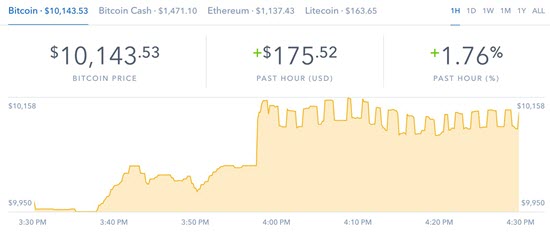
Bitcoin just spent a month doing something quite unprecedented: trading without volatility. After pinging up and down by 30% or more each week for over a year, it spent the month since September 6 quietly trading at around US$6500. Never more than $6100, never less than $6800. Bitcoin’s long fall from US$20,000 seems to have arrested itself at US$6000.

So does this mean it’s actually stable? I’ve looked at the graphs of many different traded things — stocks, currencies, bonds, commodities — and I’ve never seen anything move like bitcoin.
Commodity prices in regulated markets tend to look like what is called a random walk. A random walk is a mathematical phenomenon that can’t be predicted, and visually includes a lot of jagged sharp turns of different sizes. Bitcoin rarely has this appearance. It often trades strangely flat, then leaps up just as oddly. One of the weirdest price patterns I ever saw happened in January, and looked like crenulations:

There may be a perfectly good explanation for this. But there is also lots of evidence emerging about just how vile the cryptocurrency markets are. They are stuffed with scams and bursting with fraud.
There’s a great quote about gambling in the movie Rounders: “If you can’t spot the sucker in your first half hour at the tab, then you are the sucker”. If you’re not perpetrating fraud in crypto markets, it could be perpetrated on you.
Here are the major scams going on in crypto at the moment:
Pump and dump
This is the simplest to understand. A group gets together and agrees to all buy a certain cryptocurrency, while advocating it intensely online. The coin’s price rises, then they sell. The timing can be minutes or days.
The pump and dump is famous for leaving many of the eager participants out of pocket. The organisers buy the cryptocurrency before they advise others of the target. As the suckers start to pump, the organisers move to dump. In some more organised groups, this is acknowledged, and you can pay to move to a more inner circle of the group.
Pump and dumps are illegal under US and Australian law. The United States Commodity and Futures Trading Commission issued a warning against them this week, and is offering large cash rewards to informants who help them fine perpetrators.
Manipulation by bots
A lot of the trading going on is by robots that manipulate prices. The activity is brazen, with users of bots happily telling The Wall Street Journal about it. Nevertheless, the US government is investigating.
Wash trading
Imagine you go onto eBay. You try to sell a bike. At the same time you search for another bike, put in a bid and buy that bike. eBay sends you a message: your bike is sold. You’ve bought your own bike! Of course, eBay wouldn’t let that happen.
But many online cryptocurrency trading software will allow you to buy your own sales. This is called wash trading, and it results in a situation where many or most of the trades going on — and the prices they happen at — are not real.
Fake trade volume can hurt as much as fake prices. If you sign up to join a cryptocurrency exchange because you think it is busy, liquid and legitimate, you may be wrong. Many crypto exchanges have disappeared in the past, taking investors’ coins with them.
And then there’s Tether…
Tether is designed to be different to the other cryptocurrencies. Rather than appreciating wildly, each Tether is supposed to remain equal to one US dollar. On Thursday night, they were trading at 99.754 cents, so pretty close.
2.8 billion Tether are in circulation, and supposedly, for every Tether in circulation there is a US dollar in a bank account somewhere. Does it really sound credible that a cryptocurrency has $2.8 billion in the bank?
So is Tether a scam? Some people definitely think so, including eminent American economist Nouriel Roubini. Roubini argues Tether is being printed without any backing, and sold for bitcoin, thereby propping up the entire market for bitcoin.
It is certainly the case that surges in the printing of new Tether and surges in the price of bitcoin have occurred at the same time, and some American academics think it’s to blame, but hey, maybe the causation flows the other way.
If Tether is a scam, it is on a scale that is almost too big to fail. And we know how that can end.
Enjoy crypto carefully.








All these cryptocurrencies are pyramid schemes.
On tradition currency, the value of the currency was backed by real material goods(ie gold). Fiat currency the value is determined by the labour it represents.
Cryptocurrencies value is determined by it’s own scarcity.
Also, it is ridiculous that humans are digging coal and precious metals out of the ground to make computers put em in warehouses and then power then to complete arbitrary mathematical equations in order to create a bunch of 1’s and 0’s.
We really are destined for extinction… burning finite resources to make nothing and then celebrating our cleverness in achieving it.
Traditional*
I think that it was one Gulbenkian, of the robber barons of the roaring 20s finance boom who, when asked how he’d become so rich, replied “By selling too early”.
Cryptocurrencies discussion had a major forum in a surfing website – actual surfing – in the ocean.
There were quite a few eager beavers in there, all read up and telling us about what was valuable and why etc. So many insisting on ‘holding’ pretty much forever.
Some had a bit more sense, selling off small portions when it was around the $10K mark, but their enthusiasm was both sweet and naive in the extreme.
I made the point that if you can’t tell who the fool is in the room, you’re it.
Couldn’t talk them down, though I tried.
As the old adage goes, when the surfing websites are making recommendations on cryptocurrencies, it’s time to sell!